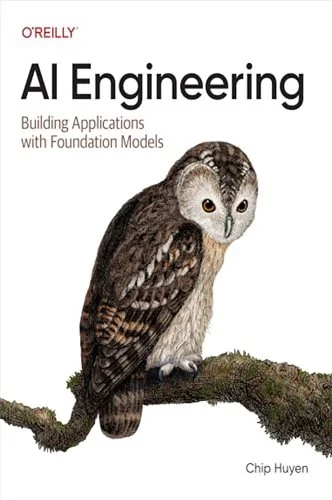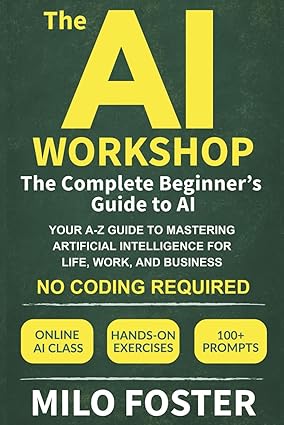By Chip Huyen
📘 Overview
AI Engineering is a practical and forward-thinking guide that covers the full lifecycle of building AI applications—from conception and model evaluation to deployment, monitoring, and iteration. Published December 2024 by O’Reilly, it’s a 528‑page ebook aimed primarily at engineers, technical product managers, and developers making the leap from traditional ML to foundation-model–driven systems Reddit+15O’Reilly Media+15Medium+15.
Chip Huyen, an influencer in AI systems design—formerly with NVIDIA, Netflix, Snorkel AI, and now co-founder of Claypot AI—brings a clear focus on real-world engineering practices, not just theory O’Reilly Media+6Amazon+6Barnes & Noble+6.
👍 Pros
1. End-to-end Framework
The book lays out a strong, structured framework for AI application development, with distinct phases: ideation, model evaluation, prompt design, retrieval, fine-tuning, inference optimization, and system deployment Medium. This makes what may start as an overwhelming process approachable and repeatable.
2. Balanced Breadth & Depth
Chip achieves an impressive balance. She dives into complex topics like RAG, LoRA fine-tuning, and AI-as-a-judge evaluation, but illustrates them with intuitive analogies and practical examples. According to Goodreads users, it’s both accessible and substantial Rakuten KoboO’Reilly Media+4Goodreads+4Barnes & Noble+4.
3. Timeless Principles Over Fads
Instead of chasing every new model release, the book emphasizes foundational engineering principles that will remain relevant despite rapid AI development O’Reilly Media+5Medium+5Amazon+5. This future-proofs your learning investment.
4. Well-researched & Candid
It doesn’t shy away from the pitfalls of foundation models—hallucinations, prompt injection vulnerabilities, evaluation gaps. These are backed by literature and case studies stefangaller.at+8tensorlabbet.com+8GitHub+8. Chip even critiques some historical claims (e.g., GPU uses) and provides sound, researched insights into biases and model quirks .
5. Widely Recommended by Practitioners
Multiple reviewers (Amazon, Goodreads, Amazon.ca) describe it as “the reference” and “indispensable” for deploying LLM‑based applications. One reviewer said it “summarised the past few years … concise and understandable format”—clearly resonating with industry needs Amazon Australia.
6. Author Credibility & Practical Cred
Chip’s background in systems and education (Stanford course, MLOps Discord, real-world roles) reinforces the book’s engineering-first perspective Reddit+1Reddit+1.
👎 Cons
1. Relatively Light on Code
The book is concept- and architecture-heavy, with minimal code. For readers who expected code-heavy tutorials (like some O’Reilly ML titles), this might feel frustrating .
2. Verbose & Qualitative
Some chapters prioritize qualitative insights over formula-driven analysis, which makes reading a bit dense or slow-paced for those seeking mathematical rigor .
3. May Be Too High-Level for Experts
Experienced AI engineers might find parts of it introductory. As one Goodreads reviewer noted, the material leans toward high-level foundational knowledge, suitable for mid-level readers .
4. Contains Minor Historical Oversights
The narrative includes claims like “AlexNet was the first use of GPUs for neural nets,” which some reviewers pointed out lacks nuance tensorlabbet.com. These don’t affect engineering advice but show it isn’t flawless in historical accuracy.
🎓 Why You Should Learn from It
- Holistic Engineering Lens – Most AI resources are tuned toward data scientists or researchers. This book fills the engineering gap—how to architect, evaluate, deploy, scale foundation-model applications in production Medium+4O’Reilly Media+4GitHub+4.
- Future-Proof Frameworks – Emphasizing transferable principles (such as continuous evaluation, modular architecture, feedback monitoring) reduces the risk of technical obsolescence .
- Real‑World Mindset – The empathetic yet pragmatic writing style—bridging theory and practice—ensures readers grasp immediate applicability. Many remarked on its utility for engineers transitioning to GenAI work .
- Trustworthy Alertness – The candid exploration of LLM failure modes (hallucinations, security issues) equips readers to build safer, more reliable AI systems—not just flashy demos GitHub.
⚠️ Why You Might Not Learn from It
- You Want Hands-On Code – If your goal is to follow practical coding examples or build prototype systems immediately, this book may disappoint. Instead, you’d need external repos or more implementation-heavy texts.
- You’re Already Deep in LLM Production – Seasoned AI engineers may find this material introductory. Advanced readers might prefer domain-specific deep dives (like production fine-tuning or scaling LLMs beyond typical workloads).
- Need Tactical Tools over Principled Frameworks – If you’re looking for critiques of vendor platforms (OpenAI vs. Anthropic) or up-to-the-minute tools, this book sticks with concepts and assumes tool choice is mostly interchangeable.
📝 Summary
AI Engineering by Chip Huyen is a substantial, well‑structured, principled guide for anyone building AI applications using foundation models. With strong frameworks, practical case discussions, and careful awareness of pitfalls, it strikes a thoughtful balance. Reviewers call it “comprehensive but practical” , and “a must-read” for engineers moving toward GenAI .
However, if your need is hands-on code, deep system internals, or you’re already LLM veteran, this might feel like it scratches the surface. That said, the book’s emphasis on timeless engineering principles and whole-lifecycle discipline make it a solid foundation—ideal even as a perspective-builder or reference manual.
🔎 Final Verdict
Should you learn from it?
✅ Yes, if you’re an AI/ML engineer, developer or technical PM wanting structured mental models and best practices for building robust GenAI systems.
⚠️ Maybe not, if you’re seeking a cookbook of deep code examples or are already a seasoned LLM systems expert.
TL;DR Table
| Strength | Weakness | Ideal For | Less Suitable For |
|---|---|---|---|
| Full AI product lifecycle understanding | Limited coding depth | Architects & ML engineers | Code-focused beginners |
| Strong foundations, evaluation-first | Qualitative and verbose | Tech managers | LLM production veterans |
| Addresses real-world pitfalls | Light on tooling | Students of AI products | Researchers needing theory/maths |
In short: AI Engineering is a strategic investment—equipping you with the mindset and frameworks needed to build reliable, scalable AI applications, rather than a how-to guide on syntax or vendor tools. If you’re building LLM-based products today or directed toward production systems, it’s a smart and worthy read.
You can purchase this ebook on ebooks.com.


